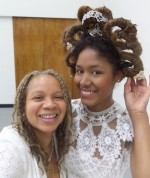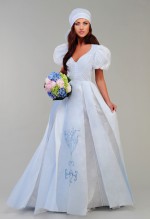Column Name
Title
To Marie Jeanne Dusseck, a wedding dress evokes cultural tradition, ceremonial ritual, and sentimental value. A Brazil World Cup-inspired wedding dress she created in the spring was the latest in a series of symbolic costumes she has designed, sometimes to celebrate world events, sometimes to process tragedies. The Brazilian dress, a kind of thank-you gift to a country she has come to love over more than a decade’s worth of visits, was exhibited in Rio de Janeiro during the tournament and New York when she got back. Another dress had more somber origins. Marie Jeanne is originally from Port-au-Prince, Haiti, and her older brother was killed in the January 2010 earthquake that devastated the country. She talks about both garments below. Marie Jeanne, who speaks five languages and is learning a sixth, went to high school in Andalusia, Spain, and eventually made her way to New York; she’s worked at Juilliard since 2007.
Body
Your job is first hand—what does that mean?
I partake in the building of costumes, which involves, cutting, hand- and machine-stitching, draping and pattern tracing, assisting in fitting, and making alterations to existing garments. There’s always something exciting and challenging, and it’s most gratifying to see it all come alive on stage.
What did you do before Juilliard?
I worked for 10 years as a costumer at Atta Studios [a New York City custom design and fabrications studio]. I would build costumes and dress life-size figures and sculptures that were commissioned by individuals, galleries, and museums. The trick was to strategically leave parts of the garment open, and once it was on the sculpture, I would stitch it closed by hand. The largest project was built for a Smithsonian exhibit about locomotion from 1800 to the 1980s.
Do you have a favorite Juilliard memory?
The 2013 tribute to Marvin Hamlisch (Pre-College ’63; faculty). The concert included names like Liza Minnelli, Barbra Streisand, and Aretha Franklin. I would have been happy enough to listen via the speaker at the Costume Shop, but that afternoon, we got an email that some seats would be available, so I stood in line for over an hour and got to see them on stage.
You have a master’s degree in museum studies and costume conservation—what was your particular interest?
To learn about costume history so I could better understand and appreciate the art. I marvel as I look at an 18th-century piece put together painstakingly by hand. The craft is perfect and inspiring—it’s a continuous learning experience.
What was your favorite vacation?
After my brother perished in the earthquake in Haiti, I mourned for him and for my country. As I slowly emerged from the grief, I needed something to get excited about, and I found myself in South Africa for the World Cup. I met people from all stations in life (including people a Juilliard colleague had put me in touch with), and they were so kind and giving. When I thought of their survival of the hardships of apartheid, I was touched by their example of strength.
Tell us about the Brazil dress.
Since the dress, Deusa, was inspired by and dedicated to Brazil, I incorporated two strong elements of the Brazilian culture: the Orixas religion of Salvador, Bahia, and the national passion for futebol. I used doilies embroidered in techniques typical of that region that I had bought there 10 years ago and to celebrate the World Cup, I had soccer balls hand-beaded in the Brazilian green and yellow in the skirt lining.
And how about the Haiti dress?
That’s my favorite—it’s called Erzulie. It was a tribute to Haiti, with proceeds donated to earthquake relief efforts by a health organization called Gheskio that’s supported by Weill Cornell Medical College. As I came up with the concept and draped the cloth, I was transported and it became my vehicle for healing after the earthquake. In honor of peasant women, I chose the color blue to represent blue calico work clothes and head wraps. The bodice panels spell Haiti with an upside-down A with fagoting trim. Each bar on the dress stands for souls who perished and the skirt’s center-front panel has an embroidered tree of life that symbolizes hope. After I saw the gown on the model at the photo shoot, I was overwhelmed with emotions, I cried.






